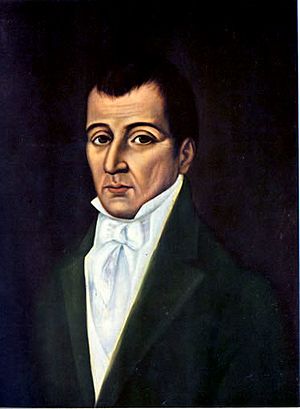Joaquín Camacho facts for kids
Quick facts for kids
Joaquín Camacho
|
|
|---|---|

1825 portrait by Coriolano Leudo
|
|
| President of the United Provinces of the New Granada* | |
| In office October 5, 1814 – January 21, 1815 |
|
| Preceded by | Camilo Torres Tenorio |
| Succeeded by | Triumvirate Custodio García Rovira, José Miguel Pey de Andrade, Manuel Rodríguez Torices |
| Personal details | |
| Born |
José Joaquín Justo Camacho Lago
July 17, 1766 Tunja, Boyacá, Viceroyalty of the New Granada |
| Died | August 31, 1816 (aged 50) Bogotá, Cundinamarca, United Provinces of New Granada |
| Spouse | Marcelina Rodríguez Lago y Castillo |
| Alma mater | Our Lady of the Rosary University |
|
|
José Joaquín Justo Camacho Lago (born July 17, 1766 – died August 31, 1816) was an important leader from the Viceroyalty of the New Granada. This area is now known as Colombia. He was a lawyer, journalist, and professor. Camacho worked hard to help New Granada become independent from Spain. He was also one of the people who signed the first Declaration of Independence. Sadly, he was executed during a difficult time called the Reign of Terror. This happened after Spain invaded New Granada again.
Contents
Early Life and Education
Joaquín Camacho was born on July 17, 1766, in a city called Tunja. At that time, Tunja was part of the Viceroyalty of the New Granada. Today, it is in Colombia. His parents were Francisco Camacho y Solórzano and Rosa Rodríguez de Lago y Castillo.
He went to Our Lady of the Rosary University. There, he studied Jurisprudence, which is the study of law. In 1792, he became a lawyer. He was known as one of the best lawyers in the viceroyalty. Many people admired his legal skills.
On June 13, 1793, Camacho married Marcelina Rodríguez de Lago y Castillo. Her family was well-known. Joaquín and Marcelina had three children together.
Sharing Ideas Through Writing
Joaquín Camacho was also a talented writer and journalist. In 1808, he won a writing contest. He wrote about the causes and treatments for goitre, a medical condition. This showed his interest in helping people.
He also wrote for a newsletter called Seminario del Nuevo Reino de Granada. This newsletter was put together by Francisco José de Caldas. In 1809, Camacho wrote a detailed description of the Province of Pamplona. He wrote about its cities, plants, animals, and borders.
In 1810, Camacho started working more in journalism. He helped create a newspaper called Diario Político with Francisco José de Caldas. The first issue came out on August 27, 1810. This newspaper shared political articles about the important events happening at the time. It was published three times a week until February 1811.
The Day of Independence: July 20, 1810
On July 19, 1810, a group of independence leaders met in secret. They included Camilo Torres Tenorio, José Acevedo Gómez, José Miguel Pey, and Jorge Tadeo Lozano. They met at the Astronomic Observatory in Bogotá. They had heard that the Spanish planned to arrest people who wanted independence. So, they decided to act first.
The leaders planned a way to start a revolution. Camacho was given a special task. He was to ask the viceroy to allow a special meeting, called a Junta. They knew the viceroy would say no. This refusal would then be used to show that the Spanish did not respect the people.
The next day, July 20, 1810, their plan worked. By evening, a large public meeting, an "Open Cabildo," was held. Joaquín Camacho was part of this important meeting. This group wrote the first Declaration of Independence for Colombia. It was called the Acta del Cabildo Extraordinario de Santa Fe. This document declared the Viceroyalty of New Granada independent. Camacho was one of the people who signed it.
Working in Congress
After the Declaration of Independence, Camacho continued to serve his country. He was a representative for the Province of Tunja. He attended the Congress of the United Provinces of the New Granada. This Congress met in a town called Villa de Leiva.
Leading the Triumvirate
On October 5, 1814, the Congress made a change to the government. They replaced the single President with a Triumvirate. A Triumvirate is a group of three leaders who share power.
Congress first chose three other people for the Triumvirate. But they could not take the job. So, Congress chose José María del Castillo y Rada, José Fernández Madrid, and Joaquín Camacho instead. Camacho served as one of these three leaders until January 2, 1815.
A Tragic End
Sadly, Joaquín Camacho was sentenced to death by Pablo Morillo. Morillo was a Spanish general who led the "Reign of Terror." This was a time when many independence leaders were captured and executed.
On August 31, 1816, Camacho was executed by a firing squad. He was 50 years old. At the time, he was very sick. He was blind and could not move his body well. He had to be carried in his wheelchair to the place where he was executed.
His Family After His Death
After Camacho died, his family faced hard times under the Spanish rule. This lasted until Simón Bolívar helped free New Granada in 1819.
Camacho's wife asked Bolívar to give her a pension. A pension is money paid regularly to someone, often for their service or sacrifice. She asked for it because of her husband's sacrifice for the nation. Bolívar personally asked the Congress to grant this. In 1820, a pension was given to her.
His daughter, Indalecia Camacho, was also blind. She received a pension from Congress on May 26, 1869. His niece, Juana Martínez Camacho, married Antonio Ricaurte, another important figure in the independence movement.
See also
 In Spanish: José Joaquín Camacho para niños
In Spanish: José Joaquín Camacho para niños
- Camilo Torres Tenorio
- Francisco José de Caldas
- Spanish invasion of New Granada

